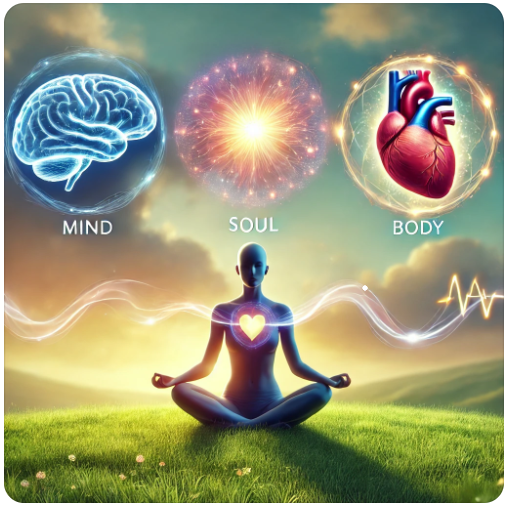Maintaining a balance between the mind, soul, and body is essential for overall well-being in today’s fast-paced world. Each aspect—mental, spiritual, and physical—plays a crucial role in shaping a harmonious life. The integration of these three dimensions fosters resilience, inner peace, and vitality. Synchronization Strategies aim to align these aspects, creating a synergistic effect that enhances life quality. This article explores various approaches to achieving this holistic harmony.
Mind-Body Practices: The Foundation of Balance
The mind and body are deeply interconnected, and balancing the two is often the first step toward holistic health. Practices like yoga, tai chi, and qigong are ancient methods designed to synchronize mental focus with physical movement. These disciplines emphasize mindful breathing, posture, and slow, deliberate motions that create unity between mental and physical states.
- Yoga: By focusing on asanas (postures) and pranayama (breath control), yoga helps cultivate a calm mind and a strong body. Its meditative aspect allows for greater self-awareness and stress reduction.
- Tai Chi and Qigong: These are martial arts practices that promote energy flow (qi) through slow, flowing movements. They help balance the body’s energy, reduce stress, and improve physical health, while also calming the mind.
Meditation: Aligning the Mind and Soul
Meditation is one of the most effective techniques to synchronize the mind and soul. Through regular practice, meditation fosters inner stillness, heightened self-awareness, and emotional balance. There are several forms of meditation:
- Mindfulness Meditation: This practice focuses on being fully present in the moment, observing thoughts without judgment. It helps in reducing mental clutter and aligning mental clarity with emotional well-being.
- Loving-kindness Meditation: This form of meditation nurtures compassion and emotional healing by focusing on sending love and kindness to oneself and others. It promotes emotional and spiritual growth.
- Transcendental Meditation: This technique involves silently repeating a mantra to transcend ordinary thought processes and achieve a deep state of relaxation and awareness, fostering a profound connection between mind and soul.
Breathwork: Connecting Mind, Body, and Soul
Conscious breathing, or breathwork, serves as a bridge that connects the mind, body, and soul. By controlling breathing patterns, individuals can influence their emotional state, energy levels, and mental clarity.
- Pranayama: This ancient yogic breathing technique involves controlling the breath to purify the body and calm the mind. Practices like nadi shodhana (alternate nostril breathing) and kapalabhati (skull-shining breath) enhance focus, energy, and emotional balance.
- Holotropic Breathwork: Developed by psychiatrist Stanislav Grof, this technique uses accelerated breathing and music to bring about altered states of consciousness, aiding in deep emotional and spiritual healing.
- Wim Hof Method: This method involves controlled hyperventilation followed by breath-holding, which helps boost physical stamina, reduce stress, and promote mental resilience.
Sound Therapy: Healing Vibrations
Sound has the power to influence mental, physical, and spiritual states. Sound therapy uses frequencies and vibrations to restore harmony within the body, mind, and soul. Techniques like sound baths, singing bowls, and binaural beats have been found to reduce stress, improve focus, and elevate mood.
- Sound Baths: In a sound bath, participants are immersed in the sound of gongs, singing bowls, and other instruments, which helps synchronize brainwaves, promoting relaxation and healing.
- Binaural Beats: These are auditory illusions created by playing slightly different frequencies in each ear. Listening to binaural beats can alter brainwave patterns, leading to deeper relaxation, heightened focus, or spiritual awareness.
Diet and Nutrition: Fuelling Body and Mind
The food we eat plays a significant role in synchronizing the body with the mind and soul. A balanced diet rich in whole foods, fruits, vegetables, and lean proteins can positively impact mental clarity, emotional stability, and physical energy. Certain foods have specific benefits for mental and spiritual health:
- Omega-3 fatty acids, found in fish and flaxseed, are essential for brain health and emotional well-being.
- Probiotics from fermented foods, such as yogurt and sauerkraut, support gut health, which is closely linked to mental health.
- Herbs and adaptogens like ashwagandha, holy basil, and ginseng help reduce stress and promote emotional balance.
Physical Exercise: Energizing the Body, Calming the Mind
Regular physical activity is crucial for maintaining a healthy body, but its benefits extend to mental and spiritual well-being as well. Exercise stimulates the release of endorphins, which can reduce stress and improve mood. Activities like running, swimming, and strength training can enhance self-discipline, boost self-esteem, and promote mindfulness when done with intention.
- Endorphin Boosting Exercises: High-intensity activities, such as interval training, can significantly enhance mood and mental clarity.
- Mindful Movement: Activities like walking in nature or gentle stretching can help calm the mind and connect with the soul, offering moments of reflection and peace.
Journaling: Bridging the Mind and Soul
Writing down thoughts, emotions, and reflections can be an excellent way to synchronize the mind and soul. Journaling allows for introspection and emotional release, leading to greater mental clarity and spiritual growth. Techniques like gratitude journaling or free-writing help individuals gain insight into their inner worlds and maintain a healthy balance between their mental and emotional states.
Spiritual Practices: Nourishing the Soul
Spirituality, whether religious or personal, plays a key role in connecting the mind and body. Practices like prayer, chanting, and reading spiritual texts provide an outlet for self-reflection, grounding, and connection to something larger than oneself. Spirituality fosters resilience and provides a sense of purpose, enhancing overall well-being.
- Prayer and Chanting: These practices help cultivate a sense of peace, gratitude, and connection with the divine or higher power, aiding in mental and spiritual synchronization.
- Rituals and Ceremonies: Engaging in rituals—whether cultural, spiritual, or personal—can help bring a sense of rhythm and meaning to life, aligning mental focus with spiritual values.
Sleep: Restoring Mind, Body, and Soul
Sleep is essential for recharging the body, calming the mind, and restoring the soul. Establishing healthy sleep habits, such as maintaining a regular sleep schedule and creating a relaxing bedtime routine, ensures that the body and mind can synchronize through restorative rest.
Conclusion
Synchronizing the mind, soul, and body is a dynamic and ongoing process that requires intentional practice. Through meditation, breath work, sound therapy, physical activity, and spiritual engagement, we can foster a sense of inner harmony and well-being. By making time for self-care, reflection, and mindful living, individuals can cultivate a deeper connection with themselves and experience a more balanced, fulfilling life.



